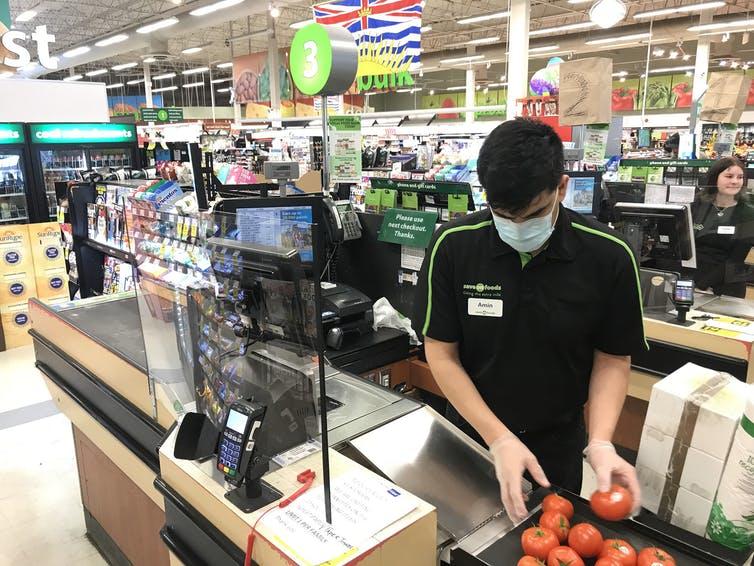Oct. 14, 2020
Managers must listen to workers of all ages on COVID-19 safety

The workplace is full of psychological hazards, including abusive supervisors and mistreatment from customers. But there are also physical hazards like falls from heights, working with faulty equipment and exposure to harsh environments — all outlined in Canada’s Occupational Health and Safety Regulations.
COVID-19, however, is both a psychological and physical hazard in the workplace. It’s different than other hazards. It is not visible. It is unpredictable. The same advice from the 1918 influenza still applies — maintain physical distancing, wear a mask and wash your hands.
- Photo above: A lifeguard disinfects mattresses used to slide down a water slide in Bromont, Que., in June 2020 as water parks reopened in the province. Photo by the Canadian Press/Paul Chiasson
Young workers, usually defined as those between 15 and 24 years old, are particularly vulnerable during COVID-19 because they often work in front-line jobs in bars, restaurants and stores. They also face more workplace hazards compared to the adult working population.
The good news is that many of the recommendations to keep young workers safe will also help to protect other workers.
Young workers: Not ‘real’ employees?
Young workers don’t typically work full time. Many are seasonal or after-school employees. They are temporary and mobile. As a result, they are often not considered “real” employees by their employers.
Full-time, year-round employees, hopefully, get workplace safety training, but young workers may not. And with only a few months spent on a summer job, 15-year-olds may not know how to respond to a hazardous workplace situation.

A Plexiglas barrier protects a cashier at a grocery store in North Vancouver, B.C., in March 2020.
The Canadian Press/Jonathan Hayward
Teens had limited employment this past summer with employers slowing down production or services during the first wave of the pandemic. These constraints may have affected the risks young workers were willing to take to have some paid employment amid all the furloughing and layoffs.
Young workers may not assess the risks of COVID-19 properly, not because they are young and impulsive, but because they have no previous experience in dealing with a threat of this kind, particularly in the workplace.
One of the misconceptions about teenagers is that they are reckless or they feel like they’re invincible. That is not necessarily true. Adolescents certainly take more risks in many domains such as driving, unsafe sex and substance use. But like many adult workers, very few young workers have worked during a pandemic.
Young workers don’t speak up very much
When faced with declining safety conditions, our research shows there are several courses of action that young workers consider:
Exit — They leave the job or situation when they feel the work is unsafe.
Voice — They speak up and make suggestions about how to improve workplace safety.
Loyalty — They choose to follow the instructions or examples of supervisors/co-workers without questioning.
Patience — Knowing the workplace is hazardous, they choose to be silent with the hope of not being injured, and sometimes find ways to keep themselves safe at work.
Neglect — They actively ignore safety concerns in spite of personal risks.
Even when there are declining safety conditions in a workplace, young workers don’t speak up very much. Safety threats have to be pretty serious for them to actually complain or even exit.
Encouraging safety
The factors encouraging young workers to speak up about safety are the same things that would encourage all of us to speak up.
Young workers with ideas about how to make their workplaces safer were more inclined to speak up, and three months later they reported fewer injuries, our research found.
Having a supervisor who listened and was open to suggestions about safety helped encourage young employees to share their ideas. This happened more often when young workers were more committed to their organization.
We know employers can select, train and encourage supervisors to create a culture of safety, and we have decades of research that shows what generates organizational commitment.
Here are some key factors that will encourage young workers to speak up about safety:
Supervisors need to be open and transparent about their commitment to safety. Safety meetings and supervisors wearing personal protective equipment are examples of safety commitment.
Supervisors need to illustrate that they care about employees. Informal check-ins, emphasizing the importance of safety rules, and relating personally to the challenges of keeping a workplace safe show that supervisors care.
Supervisors need to be open to hearing ideas. Employees need to feel psychologically safe to speak up about physical safety. When supervisors send unclear signals about safety, our research showed that older workers in particular stopped speaking up about their concerns. These same unclear cues did not affect young workers to the same degree, perhaps because their lack of life experience made them less attuned to interpersonal cues about whether their supervisors cared about their concerns.
During COVID-19, demonstrating a commitment to safety and employee well-being can save lives of all ages. Fortunately there are simple ways that supervisors and organizations can help to ensure their employees stay safe.





